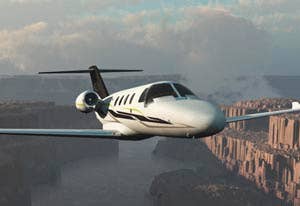
The Monday launch by Cessna of its Citation Latitude light-midsize jet threw the balance of power in the midsize market into a bit of a tizzy in a number of surprising ways.
The airplane at first seems an odd way for Cessna to innovate to win back market share in the light to midsize bizjet game. At first glance, the neo-Mustang-branded, CJ-platform M2 also seemed a strange way to create the next entry-level Wichita bird. After a few more looks, it’s nothing short of brilliant. With a CJ derivative, you get more speed, a roomier cabin, a nice lav, better legs and proven design all without cutting a single sheet of new metal in the process. Yet Cessna upped the ante by improving the engines, adding FADEC, putting in Garmin touch-controlled glass, and throwing in cutting-edge styling to create an airplane that’s a combination of tried and true and brand spanking new. And they were able to do this while cutting the price by a lot more than a million bucks.
With top cruise speeds targeted at 400 knots and an entry point at just over $4 million, the bulls-eye is squarely centered on the HondaJet, which took a big hit this week when the company announced it was pushing back certification to redesign the model’s Honda/GE engines due to the design failing ice ingestion certification tests. The redesign work promises to be both challenging and risky, as the single-piece fan will need to redone to make it beefier, which will, one presumes, require a number of other changes in cascading fashion. The news is a blow to Honda.
But it couldn’t have come at a better time for Cessna, who, with the M2, has an alternative that’s now only slightly less speedy (about 20 knots so) than the HondaJet while bearing almost none of the new-airplane risk—Cessna did that dance back in the late 1980s/early 1990s with the CJ.
The light-mid Latitude—due in 2015 and going for around $15 million—strikes a different argument and takes on a different competitor. The airplane, Cessna was reported to have confirmed, is aimed squarely at taking sales from formidable competitor Embraer, whose Legacy 450 jet is due out around the same time. The question of why Cessna chose to spend its capital on a smaller midsize model instead of going after the 450's larger midsize stablemate, the Legacy 500, is clear. The Latitude will offer a terrific cabin (the best in Cessna’s lineup), remarkably clean and passenger-friendly interior design, good speed (better than 440 knots) and a competitive price tag, along with Cessna’s world-class customer support cred thrown in for good measure. It’s a compelling proposition.
The fly-by-wire, head-up capable Legacy 500, due out in 2013, has more cabin and is more technologically advanced than the Latitude. For Cessna the prospects of going head to head against such an aircraft (which, realistically, it could not have beaten to market) was a bad bet.
The Latitude, on the other hand, will only require a new fuselage—Cessna engineers are doubtless rolling their eyes at my use of the adverb “only” here—while it will be able to leverage the work in progress on a couple of other noteworthy fronts, avionics and engines, with 300-series Pratts and the emerging Garmin G5000 touch-controlled flight deck. Withe the Latitude looking like a good bet to earn certification slightly more than a year after the Legacy 450, the timing looks good for Cessna, especially since many companies have said their purchase plans are currently soft for the next couple of years. For many of them, deliveries in 2015 or 2016 sounds just about right.
So for both the M2 and Latitude, what seemed like odd moves at first blush look like strokes of genius in the light of day, especially considering the broad smiles on the faces of Cessna sales folks when they are asked about orders at the show. They can’t comment and they don’t need to.

Sign-up for newsletters & special offers!
Get the latest FLYING stories & special offers delivered directly to your inbox






